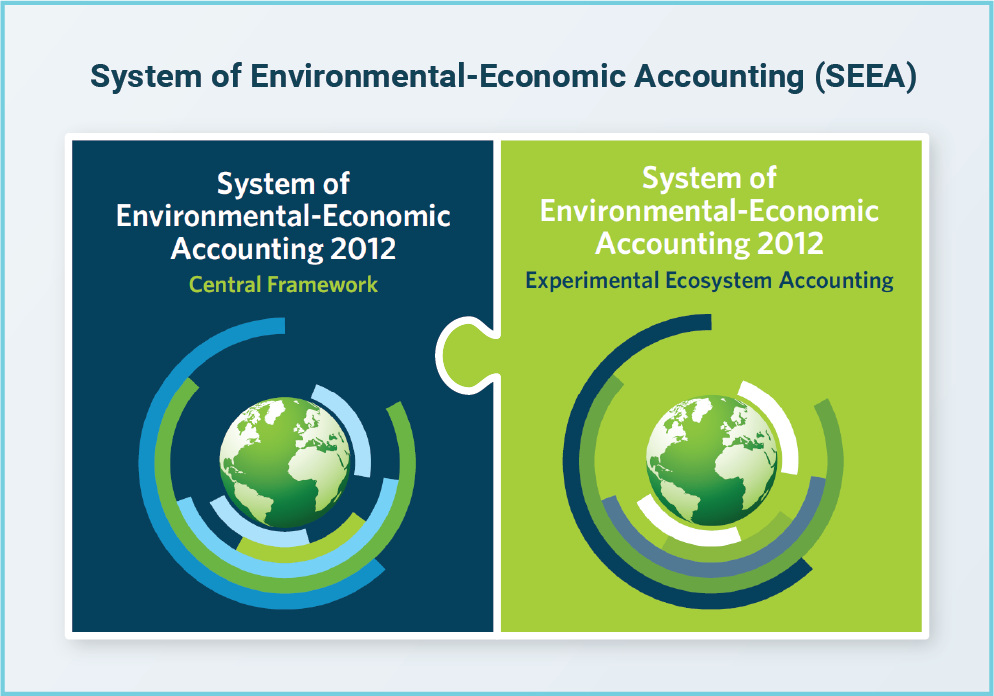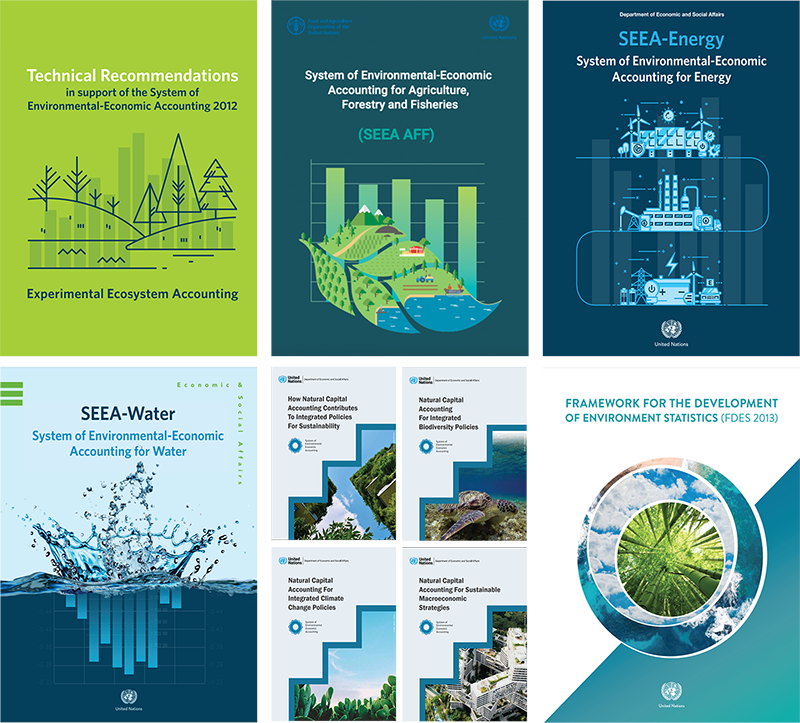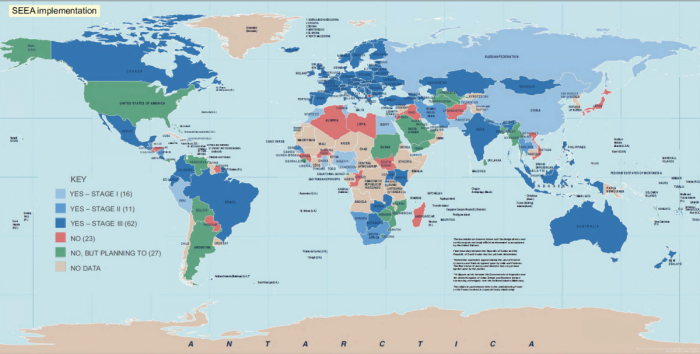10.6 Environmental accounts#
10.6.1 System of Environmental Economic Accounting#
Policy and decision makers require consistent, comparable and comprehensive statistics and indicators that consider interlinkages and dependencies across different domains. Integrated policies depend upon integrated information.
Unfortunately, in many cases, the production and dissemination of the various statistics relevant to sustainable development have remained relatively disparate, following the traditional data silo approach, rather than an integrated systems approach.
Moreover, given that data collection often involves many different agencies with different scopes of responsibility, there is usually limited collaboration in the collection, management and sharing of data across institutions. This is particularly true for environmental information and policies.
To address these problems, the System of Environmental-Economic Accounting (SEEA) is the international statistical standard for measuring the environment and its relationship with the economy. It follows an integrated systems approach. In particular, it applies an accounting approach to measuring the environment. As such, the concepts, definitions and classifications are broadly consistent with the SNA, thus facilitating the integration of environmental and economic statistics.
The SEEA has two parts:

the SEEA-Central Framework (SEEA-CF), the SEEA-Experimental Ecosystem Accounting (SEEA-EEA). In addition, the SEEA Applications and Extensions (🔗) illustrate to compilers and users of the SEEA-CF how the information can be used in decision making, policy review and formulation, analysis and research.
The SEEA-CF looks at individual environmental assets, such as water, energy, forests and fisheries resources and how these assets are extracted from the environment, used within the economy and returned back to the environment in the form of air emissions into the air and the water as well as waste. It was adopted by the UNSC as the first international standard for environmental-economic accounting in 2012.
The SEEA-EEA complements the SEEA-CF and represents international efforts towards a coherent accounting approach to the measurement of ecosystems. Ecosystem accounts enable the presentation of data and indicators of the level and value of ecosystem extent, ecosystem condition and ecosystem services in both physical and monetary terms in a spatially explicit way. The SEEA-EEA is currently being revised (🔗) with the intention of reaching agreement on as many aspects of ecosystem accounting as possible by the end of 2020.
Both, the SEEA-CF and SEEA-EEA provide the framework for measuring natural capital and make explicit the relationship between the environment and well-being, which is not depicted through traditional measures of economic activity, such as GDP and national income.
Because of its integrated nature and its reliance on scientific knowledge, the SEEA is a catalyst in bringing together users and producers of information on the environment and the economy. It is also an important tool in enhancing the new role of the NSO as data steward, taking the role of coordinating the production of data, including Big Data, to respond to new policy demands that take the environment into account.
Of course, effective use of the SEEA depends upon good environment statistics being available.
10.6.2 Monitoring sustainable development#
A critical aspect of the 2030 Agenda for Sustainable Development (🔗) is the need for integrated policies that speak to the three pillars of sustainability—economy, society and environment—and how they work together.
More specifically, the interlinked nature of the SDGs requires an integrated approach to policy decisions, based on a better understanding of the interactions and trade-offs between the different pillars of sustainability. Thus, the integrated approach of the SEEA is well-suited to the SDGs. By eliminating data silos and highlighting interactions and trade-offs, the SEEA provides a means of monitoring progress towards the SDGs, the post-2020 global biodiversity framework, and the Paris Agreement.
Because the SEEA includes information on both individual environmental assets, such as timber and water, and on ecosystems and how they relate to the economy, it can be used to measure several SDG indicators directly. Overall, it supports direct measurement or supplemental information for 40 indicators within nine SDGs. In addition, SEEA implementation itself forms the basis of Indicator 15.9.1 on progress towards Aichi Target 2 (🔗). In addition to the SDGs, the SEEA provides a useful framework for informing climate change and biodiversity policies as well as progress towards a circular economy.
While the SEEA is well suited to help countries monitor progress towards the SDGs, it does not propose or recommend any single indicator or basket of indicators for use in developing and accessing policy. In fact, one of its major strengths is that it integrates statistics for multiple purposes and multiple scales of analysis. At the same time, there are several key aggregates and indicators that can be directly derived from the SEEA accounting tables and are of interest to policy analysis and target-setting in various domains. Importantly, because the SEEA takes a systems approach and is an international statistical standard, all aggregates and indicators derived from the SEEA are consistent and comparable.
10.6.3 Other guidelines and manuals#
In addition to the SEEA-CF, SEEA-EEA there are guidelines and manuals, which can be found online at the SEEA knowledge base (🔗), and which are summarised below.

Technical Recommendations in support of the SEEA-EEA
The Technical Recommendations (🔗) serve as an intermediate step in the transition from the 2012 SEEA-EEA to its revision, which is scheduled for completion in 2021. The aims to support ecosystem accounting-related testing and research while elaborating the concepts presented in the SEEA EEA.
SEEA for Agriculture Forestry and Fisheries
The SEEA for Agriculture, Forestry and Fisheries (SEEA AFF) is a statistical system for organizing data to enable the description and analysis of the relationship between the environment and the economic activities related to agriculture, forestry and fisheries. It is fully consistent with the SEEA-CF It applies and expands the SEEA-CF concepts and methods related to agriculture, forestry and fisheries.
SEEA-for Energy
The SEEA for Energy (SEEA-Energy) is a multi-purpose statistical framework for organizing energy-related statistics. It describes the energy mix used by the economy, the stocks and changes in stocks of energy and mineral resources including depletion, the inventories of energy held within the economy as well as current and capital expenditures to extract, exploit and distribute energy resources. It also elaborates the compilation of energy accounts, building on energy statistics and balances. The SEEA Energy supports analysis of the role of energy within the economy, the state of energy inputs and various energy-related transactions of environmental interest. It is fully consistent with the SEEA-CF. Energy information is typically presented in physical terms, but the SEEA-Energy also applies monetary valuations to various stocks and flows, based on the SEEA accounting approach.
SEEA for Water
The SEEA for Water (SEEA-Water) is an integrated approach to water monitoring, bringing together a wide range of water-related statistics across sectors into one coherent information system. The SEEA-Water is the conceptual framework and set of accounts which presents hydrological information alongside economic information in a consistent way. It is fully consistent with the SEEA-CF.
Enhance Natural Capital Accounting Policy Uptake and Relevance
Four papers on the policy applications of the SEEA have been developed under the BMZ-funded project Enhance Natural Capital Accounting Policy Uptake and Relevance (EnhaNCA). They include three separate papers on issues in biodiversity, climate change, and macroeconomic applications of the SEEA, respectively, and a paper on the overall policy applications of the SEEA.
Framework for the Development of Environment Statistics (FDES 2013)
In its 44th session, the UNSC endorsed the revised Framework for Development of Environmental statistics (FDES), 2013 (🔗) as the framework for strengthening country environment statistics programmes and recognized it as a useful tool in the context of the SDGs and the Post-2015 Development Agenda.
The Commission also endorsed:
the Blueprint for Action (🔗) which documents a way forward for making the FDES 2013 operational in countries that need guidance in starting or further developing their environment statistics programmes; and
the establishment of the Expert Group on Environment Statistics (further described below) to collaborate with UNSD in developing methodological tools, hands-on guidance, and training material that contribute to the implementation of the FDES.
10.6.4 Examples of national practices#
The examples below are from just a handful of the many countries that that UNSD has supported in compiling the SEEA.
Brazil
The Brazilian Institute of Geography and Statistics (IBGE) has been one of the pioneers in the compilation of the SEEA in South America. It has made important advances in land cover and compiles land cover and use accounts every two years. Work is also ongoing in developing energy and forest accounts. In addition, under the EU-funded project, Natural Capital Accounting and Valuation of Ecosystem Services (NCAVES), IBGE is piloting SEEA-EEA accounts in the Matopiba region. The project will analyse a number of ecosystem services, such as water flow regulation and soil retention.
Mexico
Mexico’s National Institute of Statistics and Geography (INEGI) was the first Latin American NSO to compile SEEA accounts. It is also currently participating in the NCAVES project, in which context it is developing land and ecosystem extent accounts, condition accounts and ecosystem service supply accounts (including carbon storage and sequestration, provision of crops, water supply and coastal protection).
INEGI also compiles water accounts, forest accounts (physical and monetary balance sheets), fisheries accounts and material flow accounts. The accounts are also used to derive the headline indicator Ecologically-Adjusted Net Domestic Product, which estimates the costs of natural resources depletion and environmental degradation.
India
Work on environmental-economic accounting began in 2011 when a high-level Expert Group was initiated by the Ministry of Statistics and Programme Implementation (MOSPI) with the mandate of developing a framework for green national accounts of India and preparing a roadmap to implement the framework. In 2018, the Central Statistics Office released India’s first official environmental-economic accounts containing asset accounts in physical terms for forests, land, minerals and water. MOSPI is also participating in the NCAVES project to pilot SEEA EEA accounts in both physical and monetary terms.
Indonesia
Badan Pusat Statistik (BPS) compiles both SEEA-CF and SEEA-EEA accounts. Under a UN Development Account project (🔗) Indonesia began the compilation of both energy and air emission flow accounts. In addition, BPS compiles asset accounts for land, energy and mineral resources and timber resources. In terms of the SEEA-EEA, Indonesia has developed several accounts with the support of the World Bank Global Program on Sustainability, including ecosystem extent accounts and SEEA EEA accounts for peatlands.
Malaysia
The Department of Statistics, Malaysia also participated in the UN Development Account project (🔗), compiling energy, air emission and water accounts. Under this project, the Department also developed a national plan for SEEA implementation (🔗), outlining priorities and opportunities for inter-institutional collaboration.
The Philippines
The Philippines Statistical Authority (PSA) published a Technical Report on Physical Asset Accounts: Asset Accounts for Land Cover (2010-2015). It focuses on the tree-covered areas and presents a short background on the status of forest and how the SEEA CF is operationalized. The PSA also published a report describing its experience in adopting the FDES.
Netherlands
Statistics Netherlands compiles both SEEA-CF and SEEA-EEA accounts and has been at the forefront of the implementation of the SEEA EEA. In collaboration with Wageningen University, Statistics Netherlands has developed all the core SEEA EEA accounts in both physical and monetary terms, as well as carbon and biodiversity accounts. It has also developed SEEA accounts for the Dutch North Sea.
Kenya
The Kenya Bureau of Statistics (KBS) recently began compiling SEEA accounts under the UN Development Account project (🔗). It undertook a pilot compilation of physical energy flow accounts, and now regularly compiles physical energy flow accounts in the economic survey.
South Africa
Statistics South Africa (SSA) has been compiling SEEA accounts since 2000, starting with SEEA-Water accounts. It also compiles other SEEA-CF accounts, including energy, minerals and fisheries.
South Africa is also a project country under the NCAVES project, where it is leading implementation of ecosystem accounting. SSA has piloted accounts for river ecosystems and is now focusing on national ecosystem extent, urban, protected area, marine ecosystems and species accounts.
Uganda
The Uganda Bureau of Statistics (UBOS) recently developed a national plan (🔗) for SEEA implementation and began compiling SEEA-Water accounts under the UN Development Account project (🔗). UBOS has also compiled SEEA-EEA accounts for ecosystem extent and species.
United Kingdom
The UK Office of National Statistics (ONS) compiles both SEEA-CF and SEEA-EEA accounts. It provides regularly updated SEEA-EEA accounts in partnership with the UK Department of Environment, Food and Rural Affairs. The UK ecosystem accounts have been developed by integrating bottom-up, spatially disaggregated modelling approaches with data at a national (top-down, aggregate) level. This has enabled a time series of high-level accounts for various broad habitats to be compiled, in both physical and monetary terms.
10.6.5 Further development#
United Nations Committee of Experts on Environmental-Economic Accounting
The United Nations Committee of Experts on Environmental-Economic Accounting (UNCEEA) was established by the UNSC 2005 as an intergovernmental body to provide overall vision, coordination, prioritization and direction in the field of environmental-economic accounting and supporting statistics. Its work programme is organized along with the following areas of work: (a) coordination; (b) methodological advances; (c) data collection and development; (d) capacity building; and (e) communication and response to emerging issues. Each of this area is led by a representative from a national statistical office or international agency.
The UNCEEA has established targets for SEEA implementation. By the end of 2020, the aim is to have at least 100 countries implementing the SEEA-CF and at least 50 countries implementing the SEEA-EEA. This aim is on track to being achieved. As the SEEA often does not require new data collection but rather reorganization of existing data, countries in all regions and at all stages of development are compiling the SEEA, as indicated in Figure 11. In summary, as of the beginning of 2020, over 90 countries have compiled SEEA-CF accounts and over 40 countries have implemented or are currently implementing SEEA-EEA.

Fig. 11 Countries implementing the SEEA in 2021#
To help advance the SEEA-EEA and its implementation, the UNCEEA is currently undertaking a revision of the SEEA-EEA, with the intention to reach agreement on as many aspects of ecosystem accounting as possible by 2020. The revision has been a collaborative effort between statisticians, national accountants, ecologists, environmental economists, geospatial experts and academia, and the UNCEEA aims to elevate the SEEA-EEA to the level of a standard at the UNSC in 2021. A Forum of Experts bringing together experts from different communities is organized every year to discuss advances in implementation and share experience in implementation and methodological development.
The UNCEEA is also examining the possible integration of the SEEA-CF and SEEA-EEA. Given that they are complementary frameworks, exploring the synergies between the two and creating a unified SEEA framework could bring substantial benefits.
London Group on Environmental Accounting
The London Group on Environmental Accounting (🔗) held its first meeting in 1993 and since meets more or less annually. The purposes of the Group are:
to play a leadership role in defining international best practices in the theory and practice of environmental accounting within the framework of the SEEA);
to provide a forum for the sharing of national and international expertise in this field;
to assist the United Nations Committee of Experts on Environmental Accounting (UNCEEA) with advancing methodologies and developing statistical standards for environmental accounting;
to encourage the adoption of statistical standards and best practices in the field by promoting the results of the Group’s efforts via website, concepts and methods manuals, operational manuals and other means.
The topics covered by the Group to date include:
physical flow accounts (materials, water and energy);
asset accounts for natural resources and land;
environmental activity accounts and related flows;
ecosystem accounts;
applications and extensions of environmental accounts; and
training and implementation material.
Expert Group on Environment Statistics (EGES)
The Expert Group on Environment Statistics (EGES) was convened in 2014 and comprises experts on environment statistics and related areas from all geographical regions representing United Nations member States, as well as international and regional organizations. The EGES meets annually to review the progress made in the implementation of the FDES 2013 in countries. It also assesses the progress made in the development of methodological and data collection guidance in environment statistics needed for the compilation of environmentally related SDG indicators and environmental-economic accounts, as well as for the reporting to Multilateral Environmental Agreements. Complementarily, during each calendar year, the EGES organizes its work remotely through smaller teams tasked with specific areas of work.
The main objectives of the EGES are to support the work on environment statistics led by UNSD in the following areas:
Standardization of methods, classifications and definitions in environment statistics.
Data collection, processing and dissemination of environment statistics, in particular in the areas of water and waste statistics, as well as support the work of the environmentally-related SDG indicators.
Technical cooperation, training and capacity development in environment statistics.
Coordination and harmonization of environment statistics and indicator programmes and activities.
